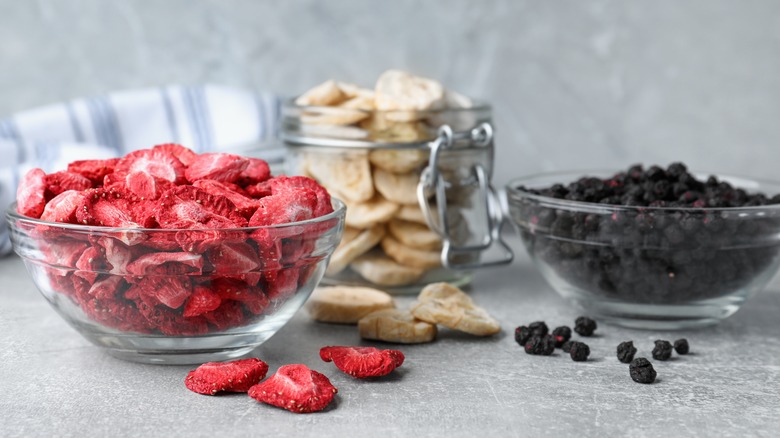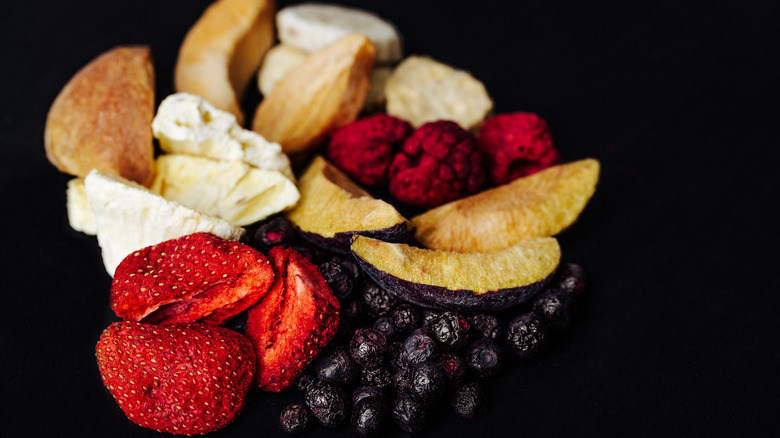How To Rehydrate Freeze-Dried Fruit With Delicious Results
Freeze-dried fruit is created by removing virtually all its moisture, resulting in a product with a shelf life of around 25 to 30 years. Freeze-dried fruits are different from dried fruits or dehydrated fruits. Freeze-dried foods are light as air and are often found in cereals, chip-like snacks, and camping meals. Dried fruits are dense, and shriveled, with concentrated flavors and a gummy or chewy texture. Dried fruits are made by sun-drying or being cooked at a very low heat over several hours. Dehydrated fruits are also made by removing moisture via heat, but they retain less liquid than dried fruits, creating a very dry and lightweight product. They need to be rehydrated to consume, but will still stay somewhat tough.
Freeze-dried foods are made by quickly freezing them to a very low temperature. Then the pressure of the product chamber is decreased, some heat is introduced — bada-bing bada-boom, science happens — and the frozen water is pulled from the fruit without melting into liquid again. Freeze-dried fruit maintains its shape, but the texture totally changes — without water, they are lightweight, porous, and styrofoam-like. Freeze-dried fruit can totally be enjoyed as is for a crisp and healthy snack or topping, but can also be rehydrated. The texture, flavor, and even appearance is almost the same as their fresh state once they have a soak. Water isn't the only thing you can use for rehydration — any liquid will work! Juice, liquor, wine, or tea could all stand in for water.
How to rehydrate freeze-dried fruit
Freeze-dried fruit acts like a sponge and will absorb liquid pretty quickly. Many guides suggest a one-to-one ratio of water to freeze-dried fruit, but that doesn't always yield great results. The amount of liquid the fruit absorbs will vary depending on the type of fruit, the size of the pieces, the brand if it is store-bought, or the particularities of the result from an at-home freeze-drying machine.
Start by putting the amount of freeze-dried fruit you would like to rehydrate into a shallow bowl. Since the volume of liquid the fruit absorbs varies so much, it is best to add just enough to make a shallow pool at the bottom of the bowl. Stir every minute or so until all the liquid has been absorbed. Still crisp? Add another splash of liquid, stir, and give it a second to absorb. You can use either hot or cold liquid depending on the intended use of the freeze-dried fruit. For example, use hot water to rehydrate freeze-dried strawberries for a warm topping for oatmeal, and use cold water to rehydrate freeze-dried blueberries to stir into plain yogurt. With a hot liquid, it should take 5 to 10 minutes to fully rehydrate, and a little bit longer with a cold liquid.
Make freeze-dried fruit taste fantastic
For a nearly-instant warm ice-cream sundae topping, rehydrate blackberries or peaches in light simple syrup. Instead of standard simple syrup, which uses an equal ratio, light simple syrup uses one part sugar to two parts water, creating a syrup that is less sweet and viscous. Add a sprinkle of cinnamon or a drizzle of chocolate syrup to finish. Rehydrate raspberries or strawberries in vodka and then float them in flutes of sparkling wine for an extra fun champagne toast. Soak freeze-dried tropical fruits like pineapple, mango, or papaya in coconut water, and then add them to iced green tea for a breezy and refreshing zero-proof beverage. Give freeze-dried blueberries, bananas, or plums a brandy soak before incorporating them into quick bread or a cinnamon streusel coffee cake, or rehydrate freeze-dried apples in cider to make the most appley spiced apple muffins ever.
It is hard to resist snacking on yummy and crunchable freeze-dried fruits, but take a moment to consider which complimentary flavors can take a rehydrated freeze-dried fruit to the next level. Freeze-dried fruit rehydrated with water will still be vibrant and delicious, but why not use something a little more interesting for a serious flavor upgrade?



